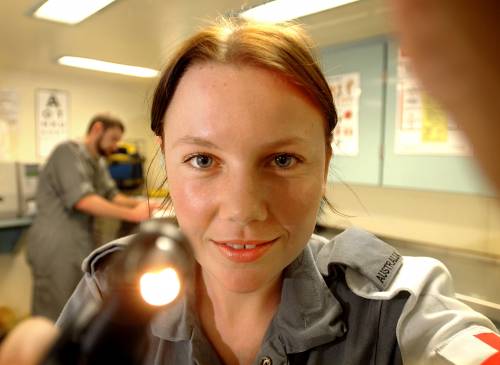Battle of Savo Island - Loss of HMAS Canberra
By J.H. Straczek
On the morning of the 9 August 1942 the Royal Australian Navy's heavy cruiser HMAS CANBERRA was sunk after being severely damaged during a naval battle off Savo Island in the Solomon Islands group. HMAS CANBERRA had been forming part of the force screening the American invasion force which had started landing on Guadalcanal on 7 August.
The object of the landing was to capture the almost completed Japanese airfield at Lunga Point on Guadalcanal and thus ensure that the vital USA-Australia supply lines could not be threatened. However, in the end, it was this campaign which was to see the strength of the Imperial Japanese Navy sapped away and eventually open the road to Tokyo.
The initial landings and capture of the airfield at Lunga Point, renamed Henderson Field, met with only light resistance ashore. However air attacks on the assault force commenced at about midday on the 7 August and were to continue during the period of the campaign. Fortunately for the Allied commanders Royal Australian Navy Coastwatchers were providing invaluable warnings of Japanese raids heading towards Guadalcanal.
Within two hours of the initial landings the commander of the 8th Fleet at Rabual, Vice Admiral Gunichi Mikawa, sailed with a cruiser force for Guadalcanal. The force under his command consisted of: the heavy cruisers CHOKAI, AOBA, FURATAKA, KINUGASA, and KAKO; the light cruisers TENRYU and TATSUTA and the destroyer YUNANGI. As this force headed south they were spotted and their position and course reported to the Allied commander, Rear Admiral Turner USN. However, when they were spotted the Japanese were sailing in an east south-east direction and then altered course back to Rabual. Thus the Americans concluded that the Japanese were not heading for Guadalcanal.
In order to protect the transports against any Japanese attack a screening force of cruisers and destroyers was deployed to patrol the approaches to Guadalcanal. This force was commanded by Rear Admiral V.A.C. Crutchley VC, DSC RN and was deployed as follows:
The American destroyers RALPH TALBOT and BLUE patrolling to the seaward of Savo Island.
The Australian cruisers AUSTRALIA and CANBERRA with the American cruiser CHICAGO and destroyers BAGLEY and PATTERSON patrolled an area to the south of Savo Island.
The American cruisers VINCENNES, ASTORIA and QUINCY with the destroyers HELM and WILSON patrolled an area to the east of Savo Island.
The Australian cruiser HOBART with the American cruiser SAN JUAN and the destroyers MONSSEN and BUCHANAN patrolled the area between Florida Island and Guadalcanal.
Unaware of the approach of the Japanese force Admiral Turner convened a staff meeting onboard the attack transport MCCAWLEY. Admiral Crutchley departed the patrol area with AUSTRALIA and proceeded to the meeting in the Transport Anchorage. As the meeting was in progress Admiral Mikawa and his force were making their approach to Savo Island.
At 0130 on the 9th August the Japanese force sighted the destroyer BLUE and reduced speed. As they approached almost all of the enemy's guns were aimed at the unsuspecting ship. However, they were not sighted and proceeded to pass Savo Island. Shortly after passing Savo Island the Japanese sighted the Southern Screening Force with CANBERRA the lead ship. At about the same time the Japanese were sighted by the destroyer PATTERSON and Japanese aircraft, launched from the cruisers some two hours earlier dropped flares over Lunga Point and the transport area.
These flares immediately silhouetted the cruisers CANBERRA and CHICAGO and the Japanese opened fire with all weapons. CANBERRA being the lead ship received almost the full force of the Japanese barrage and was immediately put out of action. CHICAGO was also badly damaged but still operational.
After rendering the Southern Screening Force ineffective the Japanese continued their sweep around Savo Island splitting into two columns and approached the Northern Screening Force at high speed.
Again complete surprise was achieved with just as devastating results. The Japanese ships opened fire on the American ships at very close range and in a short space of time the cruisers QUINCY and VINCENNES were sunk with ASTORIA being badly damaged. During this part of the action the Japanese flagship CHOKAI received hits which damaged her operations room and killed a number of personnel. Being unaware as to the location and strength of the remaining Allied naval forces the Japanese did not press home their advantage and commenced to withdraw. On their way passed the outer screening destroyers the Japanese engaged and damaged the RALPH TALBOT.
Dawn was to reveal to the Allies the full extend of the battle. The Japanese had sunk the cruisers QUINCY and VINCENNES; and the cruisers CANBERRA and ASTORIA, and destroyers RALPH TALBOT and PATTERSON were badly damaged.
Admiral Turner ordered that CANBERRA be abandoned and sunk if she could not raise steam. Once all survivors had been evacuated, SELFRIDGE fired 263 5-inch shells and four torpedoes into CANBERRA in an attempt to sink her. Eventually a torpedo fired by the destroyer ELLET administered the final blow.
The transports were now only protected by two Australian cruisers AUSTRALIA and HOBART, the anti-aircraft cruiser SAN JUAN and destroyers. Despite this naval weakness the landing operations continued and the toe hold achieved on Guadalcanal became the launching pad for the American "island hopping" campaign.
As a result of the Battle of Savo Island just over 1,000 Allied sailors lost their lives and another 700 were wounded. Casualties in CANBERRA were 84 dead and 109 wounded. Battle of Savo Island
